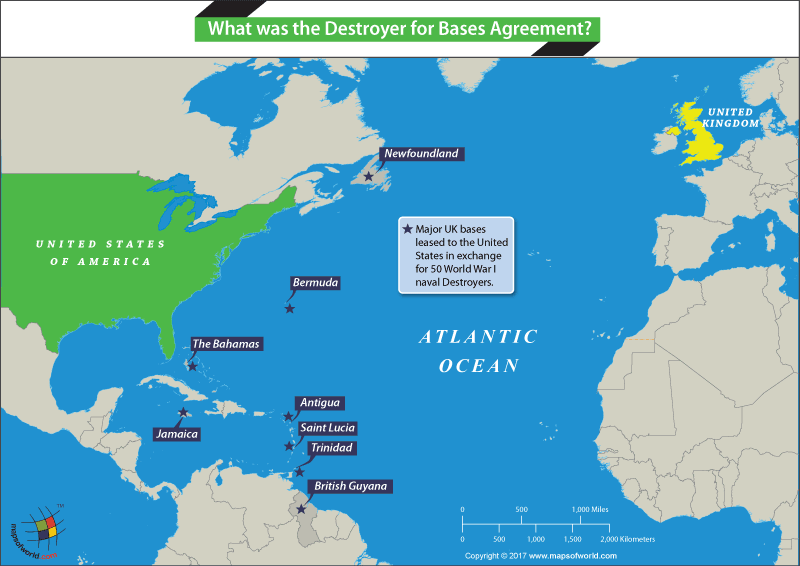What was the Destroyer for Bases Agreement?

The “Destroyer for Bases Agreement” was an agreement signed between the United States of America and Great Britain on September 2, 1940.
The Agreement authorized Great Britain to receive 50 World War I naval destroyers from the U.S. in exchange for access to land in British Colonies “free from charge” on a 99-year lease. The U.S. was to build eight naval and air facilities on the leased land, at its own cost, and the bases could subsequently be used by both countries.
The agreement was negotiated by correspondence between the U.S. Secretary of State, Cordell Hull, and the British Ambassador to the United States, Lord Lothian.
These bases were located in the Avalon Peninsula, Great Bay of Bermuda and Newfoundland. Later, additional bases were identified in the Caribbean. The U.S. received access to Bermuda and Newfoundland without any additional ships offered to Great Britain.
The 50 1,200-ton destroyers received by Britain included 27 Wickes Class, 20 Clemson Class, and 3 Caldwell Class ships.
Why the Destroyer for Bases Agreement was so important?
The Sino-Japanese war had already commenced on July 7th, 1937. On September 1st, 1939, Nazi Germany invaded Poland in a military Blitzkrieg that resulted in Britain and France declaring war on Germany on September 3rd of that year.
At this point, the United States was committed to remain neutral, as per the initial Neutrality Act signed by President Franklin D. Roosevelt on August 1st, 1935, and reaffirmed in the Resolution Number 54, Neutrality Act of 1939, passed by the 76th Congress on November 4th. The Act effectively ruled out any U.S. involvement of men or materials in wars involving other nations.
By May, 1940, France had fallen to the German Blitzkrieg, and Britain was under severe pressure holding out against the aggressive German forces.
It was increasingly becoming clear to the British Prime Minister, Winston Churchill, that Britain could lose the war to Germany if it did not receive urgent military supplies and support from the U.S. But the U.S. was committed to neutrality and was not keen on getting involved in the war.
The British PM Winston Churchill highlighted the need for U.S. involvement and support highlighting the fact that if Britain were to fall to the Germans, all territories of the British Empire, including the Islands in the Caribbean, could be the next target for the Germans, bringing them close to the U.S. shores.
By May-June 1940, the German U-boats were getting increasingly aggressive in the Battle of the Atlantic, destroying several British naval ships and disrupting war supplies to the already stressed nation.
Despite domestic pressure in the U.S. against joining the war in Europe and its commitment to the Neutrality Act, President Roosevelt took the decision to extend military support to Great Britain.
On September 2nd, 1940, the Destroyer for Bases Agreement was signed by President Roosevelt and Prime Minister Churchill. The agreement was important to the U.S. as it needed to secure the mainland by opening military bases in British colonies nearby. For Britain, the agreement would give it access to naval ships it desperately needed to stand up to the German Navy. It was a mutually beneficial agreement that was to be the beginning of a long-standing military and strategic co-operation between the two countries that stands to this day.
The major bases leased to the United States were located in these islands.
The specific bases were named by the U.S. government/military:
Antigua – Coolidge Army Airfield, Naval Air Station Crabbs Peninsula; The Bahamas – Exuma Island Georg Town; British Guyana – Aitkinson Aerodrome, Naval seaplane base at Suddie; Jamaica – Verman Army Airfield, Naval Air Station Port Royal; Saint Lucia – Beane Army Airfield; Naval Air Station Gros Islet Bay; Trinidad – Waller Army Airfield, Carlson Army Airfield.
The two bases received by the U.S. without offering any material to Britain were Bermuda and Newfoundland. The latter had Pepperrell Airfield, Goose Bay Army Airfield, Stephenville Army Airfield, McAndrew Army Airfield, Naval Station Argentia, among others.
Controversy generated by the Agreement
The agreement was the outcome of necessity and circumstance for Great Britain and the United States. In the aftermath of the naval buildup during World War I, the U.S. had large inventory of naval ships that had become unnecessary and were starting to show their age.
World War II started in 1939, and by the mid-1940s, Great Britain was already reeling under severe financial and military resource constraints. It desperately needed military equipment, especially naval ships, to ward off the Germans in the Atlantic, but had no money left to buy the much-needed equipment.
The U.S. meanwhile had a problem of excess but obsolete naval ships. The U.S. had no intention of joining the war in Europe, but was wary of German expansionist plans and was looking to secure the mainland. The lend-lease agreement seemed to address the problems of both countries. Great Britain would get the ships it needed and the U.S. access to critical bases.
However, many in Britain, including PM Churchill, believed the deal forced Britain to hand over too much land in return for obsolete equipment. This was partly true, as Britain were barely able to deploy more than 30 of the 50 ageing destroyers by 1941, due to their poor condition. The handover of British land to the U.S. in lieu of old destroyers was viewed by many critics and historians as a bad deal for Great Britain.
Related Maps:






